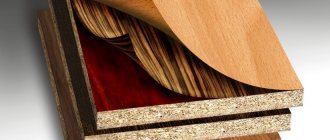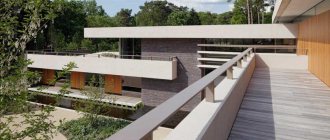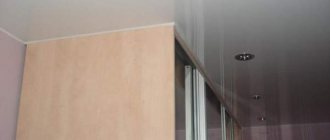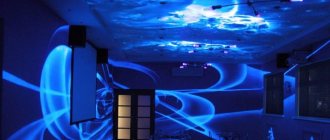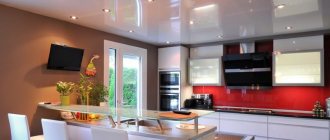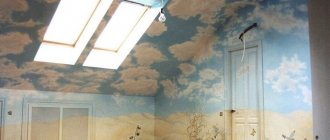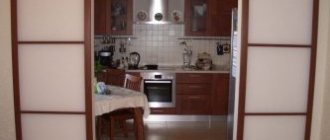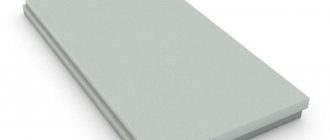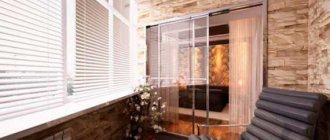While studying landscaping of their home, many strive for a beautiful decor balconies and loggias, thereby improving the design of the overall space of the apartment and creating for yourself additional facilities.
Weighing all the advantages and disadvantages of materials, everyone makes their own choice of which finishing materials to use when repairing a balcony or loggia. Modern possibilities involve finishing with high-tech materials that have a long service life and versatility in use.
Content
- Advantages of covering with plastic panels
- How to choose the right material
- Finishing with plastic panels
- Video instruction
Particularly popular for balconies and loggias is cladding with plastic panels, which are superior to many other finishing materials in their versatility and modern design capabilities. By using PVC , you choose one of the best options, thanks to the cost-effectiveness and durability of these panels.
Advantages of covering with plastic panels
The numerous advantages of this choice are obvious:
- By finishing balconies and loggias with plastic panels, you combine elegant decor with practicality , since they are durable and inexpensive ;
- without compromising the aesthetics of the external facade of the building, when using external cladding of balconies with PVC panels, the thermal insulation parameters of the balcony room increase;
- PVC panels have a reasonable price on the finishing materials market and are distinguished from them by their guaranteed service life for many years.
- not susceptible to changes in temperature , humidity and other atmospheric influences;
- do not require complex and time-consuming care , saving your time and effort;
- increase the sound insulation of a loggia or balcony
Plastic panels, like many other materials, always have a beautiful appearance, and in combination with plastic windows they look very harmonious.
MDF panels
We often see MDF panels on a balcony; let’s look at the pros and cons of this type of repair, how they differ from plastic finishes, and why they are installed.
MDF panels of various colors and shades
They are, roughly speaking, compressed wood shavings of various types and origins, printed with a pattern and treated with a special compound. They differ from PVC sheathing in their increased environmental friendliness, since they are made from wooden materials, and are superior to analogues, because harmful resins are not used in production.
MDF finishing, in turn, is superior to PVC in terms of heat conservation and sound insulation. The same cannot be said for PVC sheathing - those fixed to a metal frame create a drum effect when, when the door slams, the noise spreads across the ceiling and walls. Also, MDF sheathing is inferior to PVC finishing in terms of moisture resistance and availability in the price category.
Installation must be carried out at room temperature; before installing the sheathing, it must be left for 48 hours to adapt, which creates additional difficulties if you want to quickly make repairs, which cannot be said about PVC finishing, which is not afraid of temperature changes; installation occurs much faster.
Do-it-yourself installation of MDF is possible thanks to a special fastening. You can fasten the PVC trim with staples using a construction stapler.
MDF panels installed on the balcony
To work with PVC sheathing, a large stationery knife is enough, for large MDF boards, new types of which can reach up to 3 sq.m. You need to have at least a jigsaw.
MDF finishing is used for greater efficiency; it costs more, but has better performance than PVC cladding. They are used in children's rooms, places where people often stay; on the balcony they will help preserve precious heat and provide better sound insulation from external noise.
Recently, MDF boards coated with PVC film have appeared on the market of new types of cladding; they are absolutely not afraid of moisture, have excellent heat and sound insulation, but are characterized by a high price and complexity of installation due to the MDF base, which requires a special fastener to attach to the frame.
Whatever material we choose, it is quite possible to make a beautiful repair with our own hands; even if something doesn’t work out, then by learning from our mistakes, we will always achieve an excellent result.
How to choose the right material
Knowing full well how popular plastic panels are for interior decoration of loggias and balconies, we should not forget that one of the reasons for the popularity of this method is the durability of this material.
When choosing PVC panels, be careful . Try not to purchase finishing materials of this type on construction markets .
When making a purchase in a specialized store, pay attention to the surface of the panels. It must be free of defects : chips, cracks, etc. The paint must be applied evenly and clearly. The surface of the panels is smooth without distortion.
It is necessary to take two strips of panels and connect them, they should tightly to each other so that the seams are not noticeable. It is desirable that the panels be protected a special film , which must be removed before installation , and the panels should not emit a pungent odor, which indicates the low quality of this material.
There are plastic panels
- PVC ceiling panels;
- PVC wall panels
Recently, ceilings made of plastic panels have become increasingly popular. You will forget about painting and whitewashing the ceiling. Once you make it from plastic, you will enjoy it for many years.
A very convenient way you can use to purchase plastic panels is through specialized online stores . Fast , cheap and convenient - this is a purchasing method that will significantly save your time and money. Be sure to ask for certificate .
The color range of this material is so wide that it is very difficult to make your choice, and the best thing to do here is the help of a specialist who will advise which products to purchase and provide quality for this material.
An environmentally friendly material that does not have any toxic odors, is fireproof, and cannot be deformed due to temperature changes.
Panels are produced in a variety of options:
- classic - these are PVC panels with very different colors;
- laminated - panels for covering, which are made using a colored film with a textured finish . In addition to color, when buying such panels, you can also choose a texture that imitates natural finishing materials ;
- with thermal printing are plastic panels of various colors, on which embossed pattern
For the interior decoration of balconies and loggias, such panels are in no way plastic lining, as they surpass it in technical characteristics . They are much wider and on their smooth surface it is difficult to detect joints and seams after installation.
Plastic panels are used as a decorative finish due to the fact that they have a neat appearance, and they also help level the walls, since they are mounted level on top of the walls and remove all their unevenness and imperfections.
In addition to all that has been said, please note that PVC panels beneficial as a decorative finish because they can turn your balcony or loggia into a small room or office. They are for any design with their colors and pattern designs, the variety of which is very wide on the modern market.
Fixing PVC finishing
Fastening the walls
Attaching panels to the wall
How to cover a balcony with plastic panels correctly? There is nothing complicated about this; first, a frame is fixed around the perimeter of the walls. We fill the most problematic areas with polyurethane foam - on the floor, around the window/door, to avoid drafts, and also for a more durable fixation of the finish.
Preparing the perimeter of the balcony
Then, using a stapler or self-tapping screws, you need to attach a starting profile to it around the perimeter - a small PVC groove into which the ends of the trim fit.
A construction stapler is the best way to quickly attach PVC panels to a frame with your own hands. This method saves a lot of money and time compared to self-tapping screws, and is the main secret to quick repairs.
Then the first sheet of PVC trim is inserted, after insertion we measure according to the level so that the PVC sheet is vertical, it may fit crookedly into the profile, and the remaining sheets will be aligned unevenly.
After installation, the sheathing is fixed with a stapler; if not available, self-tapping screws should be used. The sheathing is joined using grooves, and by tapping we achieve an ideal, almost imperceptible, joint between the PVC sheets.
You should pay attention to the wiring and the future location of all elements of electrical equipment. The fastening of the elements is done immediately, until the wire is completely hidden behind the PVC finish.
Installation of equipment and all work near electrical wiring should be carried out with the voltage turned off.
After installation, you should turn on the voltage, check the serviceability and correct connection of all elements with a tester.
Installing panels on wooden sheathing
In places near windows and doors, before attaching the last sheet of trim, you need to look again and blow out all suspicious places and small cracks with polyurethane foam around the perimeter.
Particular care should be taken when attaching the last sheet of finishing to the wall: it is cut from the profile side to the required width - a few millimeters longer than necessary.
After which the cut end is tucked into the starting profile, the other is carefully driven into the groove on the adjacent sheet and moved towards it so that the gap between the fasteners disappears.
The joints that remain can be easily hidden with your own hands using a special PVC corner; it must be secured with construction silicone or liquid nails. Silicone is applied to it, after which it is fixed with tape for 24 hours.
After the required time has passed, the adhesive tape is carefully removed so that the loose fit of the sheathing elements is not visible - you need to go over the places where the starting profile is attached and at the corners with construction silicone, then run your finger along the seam - the sheathing defects will become invisible.
There is a repair technique that allows you to make the appearance of PVC sheathing more beautiful with your own hands and save on the starting profile and corners: for the internal corner, we need to use a knife to cut one cell of the trailing edge along the entire length of the sheathing, heat the part from the front side, then bend it at an angle of 90 degrees.
For the outer corner of the skin it is similar - but the more strips of cells we cut out, the smoother the transition will be; heating with this method, with a wider angle, is not necessary. But such a trick is only appropriate for high-quality PVC sheathing and large vertical joints. On horizontal floors between the ceiling/floor and the wall, it is better to install skirting boards or adjust the sheathing perfectly.
It is also better to cut off several short blanks in advance and use them as templates - stencils, because if the angle is chosen incorrectly, this is fraught with either the joint falling behind when pressing between the penultimate and corner panels, or there will be no gap between them, but creases and bends in the finish will be visible on fastenings.
An ideally selected corner should be smooth and there should be no gap between the penultimate and corner panels, and the radius of curvature should be 4-5 mm.
Securing the ceiling
We drill holes and fasten the panels with self-tapping screws
Initially, a frame is marked out, which, contrary to many opinions, as practice shows, is better made of wood. Metal profiles are justified only in large rooms with high humidity, the exception is that our neighbors will flood us and we will be calmer because the metal will not rot, unlike wood.
The ceiling trim needs to be attached carefully so as not to miss the places where the wiring is attached before the trim is finally fixed. The seams between the frame and the base on the ceiling do not need to be sealed with foam.
Finishing with plastic panels
The process of finishing a balcony or loggia with plastic panels is quite labor-intensive , although finishing with this material does not involve preliminary preparation of the walls. They can be easily sawed in any direction , which greatly facilitates their adjustment to size. Familiarize yourself with the main stages of finishing work on a balcony with PVC panels.
When starting to decorate a balcony or loggia, you should know that it is necessary to glaze, insulate and seal it, otherwise all the work becomes meaningless, after which we proceed to installing the panels:
- To install the plastic panels, it is necessary to install guides, that is, a lathing that will align the walls of the loggia or balcony. A wooden beam 20x40 mm or a metal profile is attached to the walls using plastic dowels . Mounted mortgages must withstand a load exceeding 3 times the standard one in order to be able to hang anything heavy on the walls. For example, a sports simulator.
- In order to avoid high humidity and subsequently dampness insulation and mineral wool are laid on the balcony or loggia , which is designed to regulate humidity and copes well with this, followed by laying chipboard or plywood. It is necessary to leave gaps 10-30 mm .
- A socket or lamp on a balcony or loggia will not bother anyone . In this case, all wires must be hidden under the casing using modern connectors and cables. On a warm summer evening , you could work with a laptop while sitting on the loggia, or watch a movie without having extension cables stretching across the entire apartment.
- The free space between the interior and exterior decoration is filled with insulation in order to avoid a sound effect similar to an echo.
- In order to obtain a joint without seams on the inner corners of a balcony or loggia, it is necessary to make an internal cut and then bend the panel and then the corner will look aesthetically pleasing .
- to install plastic slopes between the casing and the frame ; for this, a special joining profile is used, which helps to fix .
- All that remains is to lay the flooring and install the baseboards . Having done all this work, you will see how much free space has increased and you will be satisfied with the result.
Plastic panels are very convenient due to their easy care. They have excellent hygienic qualities, having a smooth surface and no pores. To keep them clean , simply wipe cloth and any detergent .
The panels retain their appearance for more than 10 years when used at temperatures ranging from -50 to +50o C.
Decorating a balcony or loggia with PVC panels is becoming more and more popular every year. This is a modern and beautiful way to decorate a room; in addition, this material perfectly protects from moisture and does not deteriorate from the active action of sunlight . The consumer pays tribute to the high quality of the material and its long service life.
Having completed all the work on decorating your balcony or loggia with plastic panels, all you have to do is enjoy the beautiful design and free space .
The ease with which you will put things in order while cleaning the balcony of your dreams will give you real pleasure !
How to cover a balcony without glazing
Balcony cladding without glazing is made using materials that are used for external cladding: plastic and metal siding, specially treated wood, corrugated board. You can also cover the walls with plaster for exterior use, decorative stone or ceramic tiles.
Finishing an open balcony involves arranging a covering, the best option for which would be a polycarbonate sheet installed on a metal or wooden frame.
Before finishing the walls on the balcony, it is necessary to consider the aesthetic component and the load on the structure after the entire area of the room has been processed.
An important question is how to properly cover a balcony with a visible fence. After all, it will be visible from the outside. The best option is to preserve the type of decoration and color of the building facade. If you wish, you can create your own original environment, slightly or radically different from the general one.
